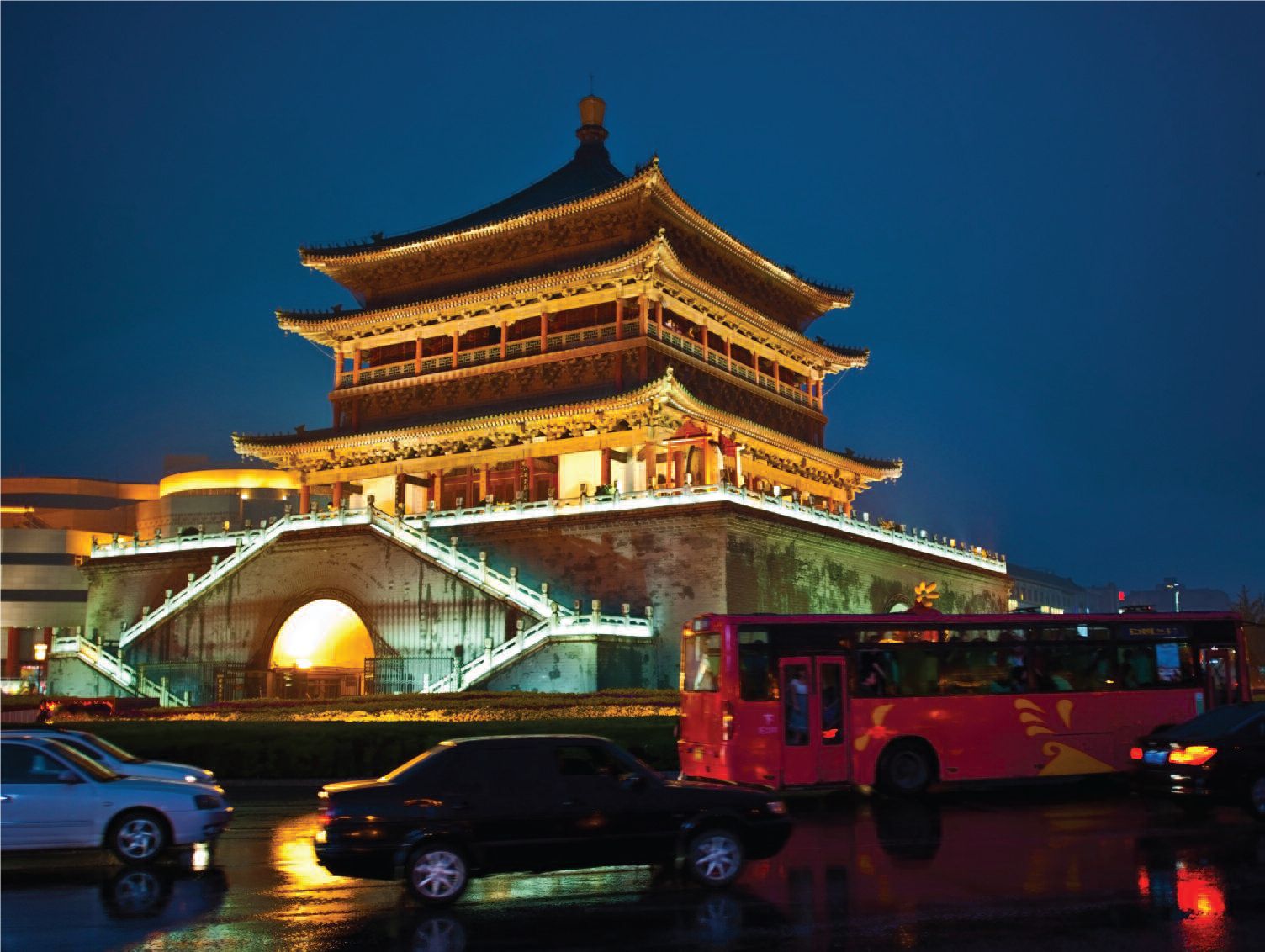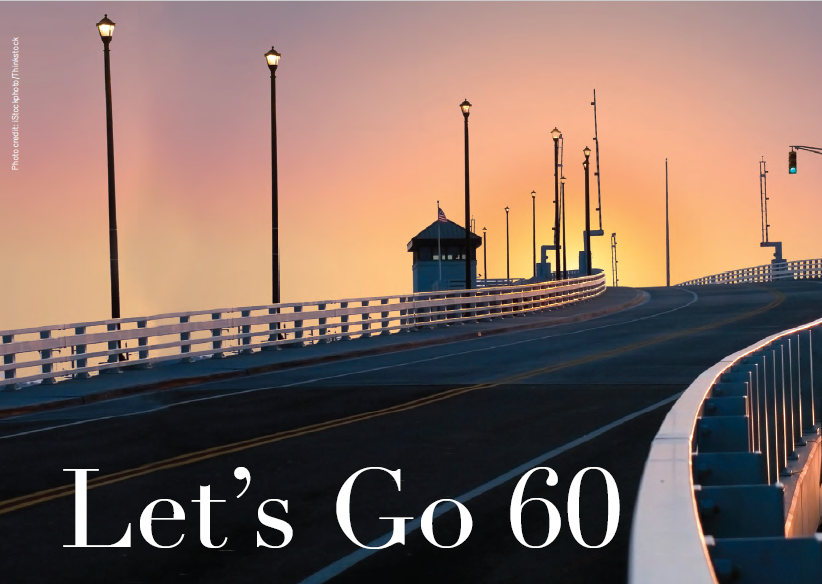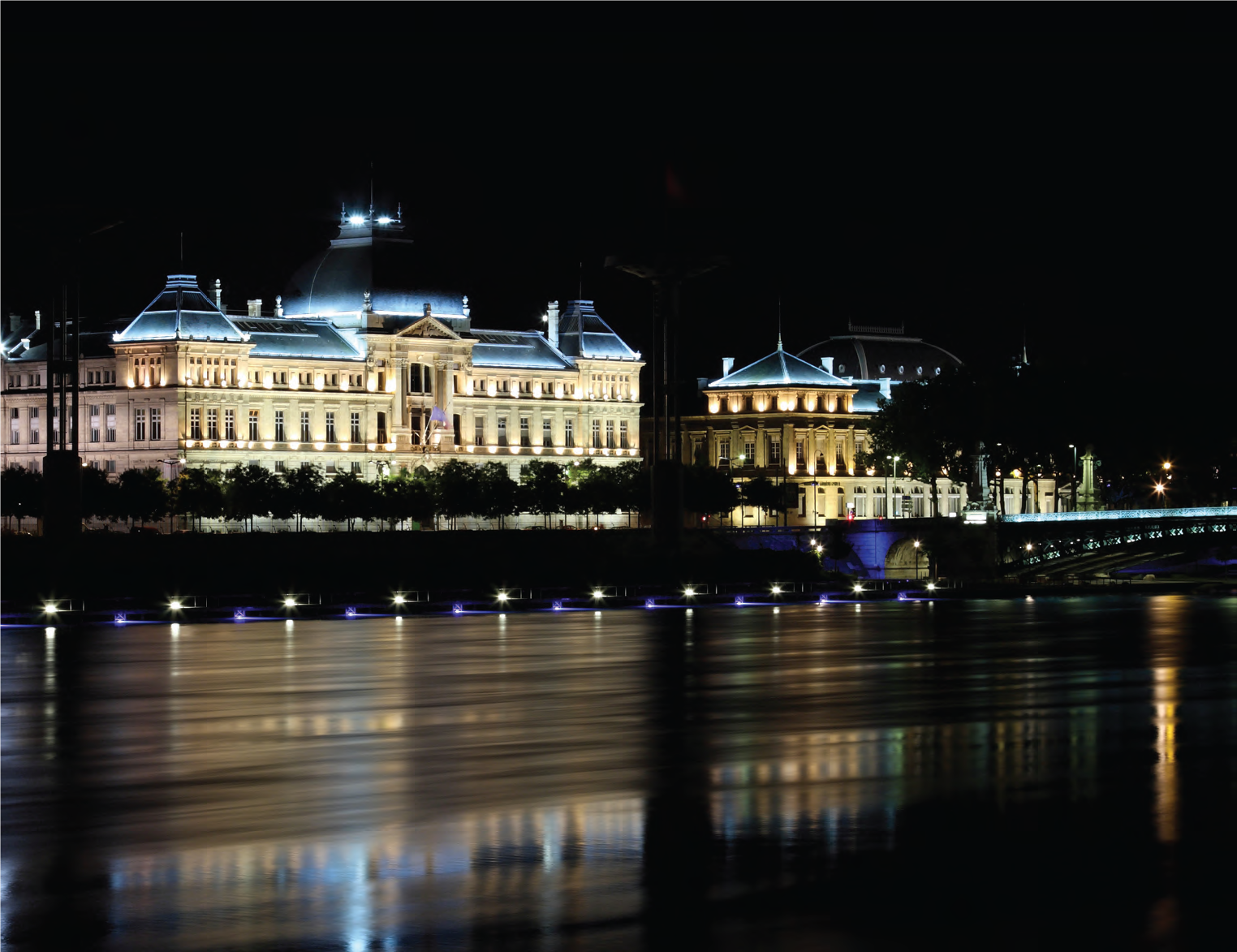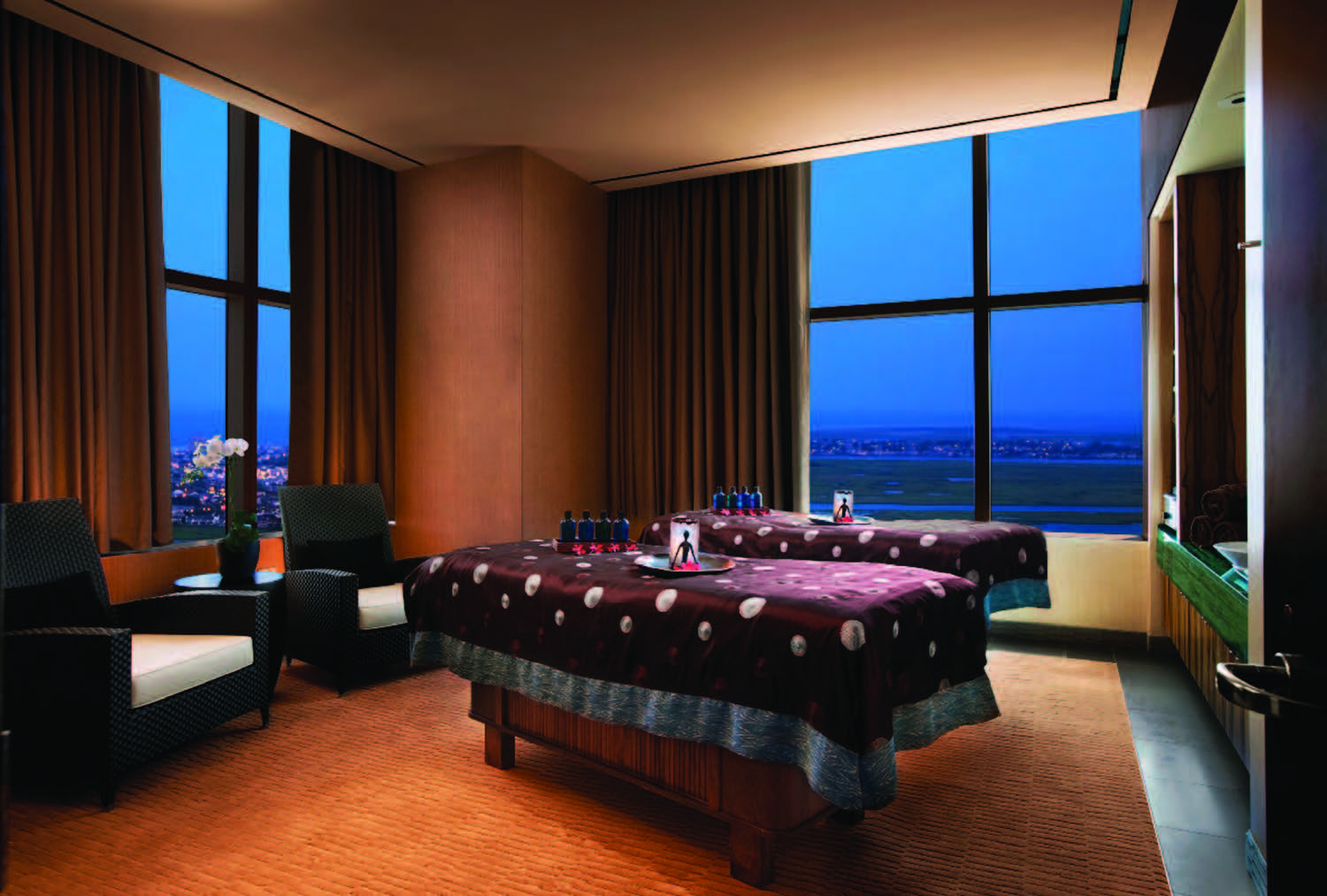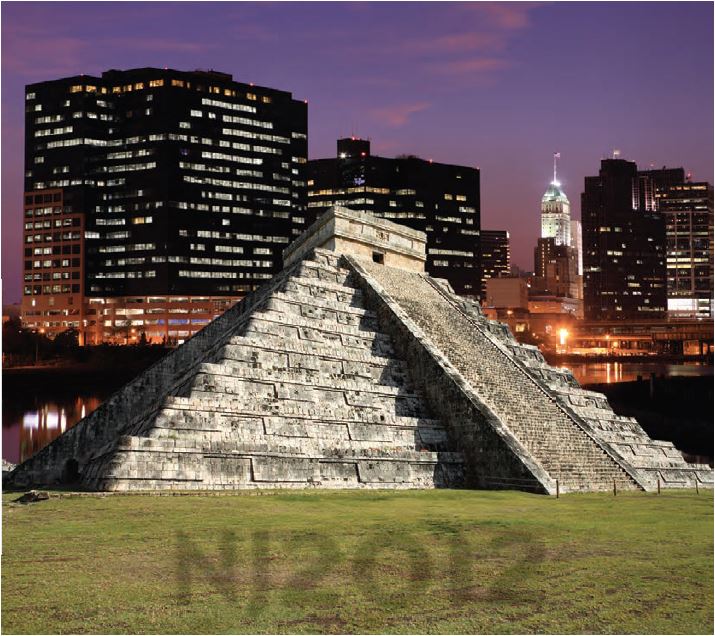- Renaissance Newark Airport Hotel 1000 Spring Street (Routes 1 & 9 South Service Road) Elizabeth NJ 07114
- (908) 994-35138
- visit website
- 105 Elm St. Westfield NJ 07090
- (908)789-9444
- visit website
New Jersey in the wee small hours
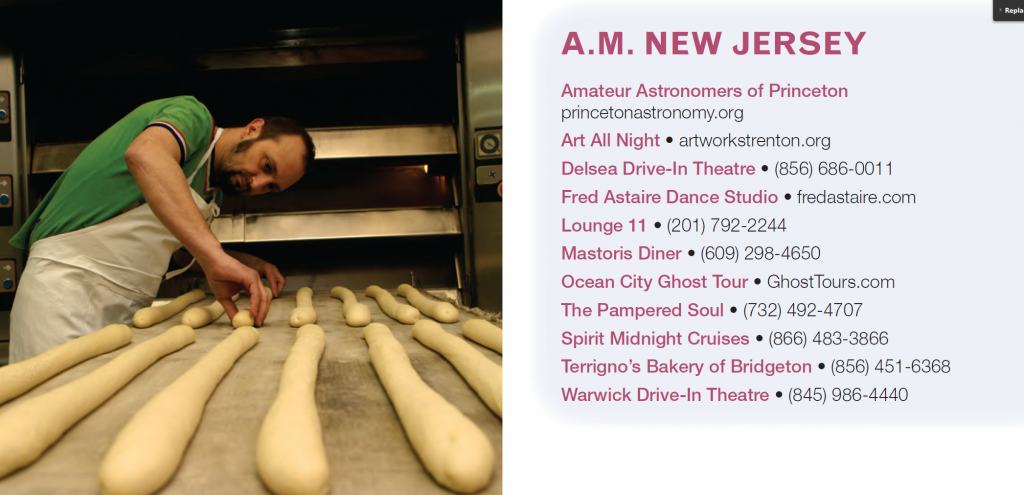
In the wee small hours, not all of New Jersey is in REM state I am an early bird. It has nothing to do with catching the proverbial worm; my day job in the financial sector simply required me to be up at the crack of dawn. No Late Night with Letterman. No Conan. No 1:00 a.m. road trips to the Wendy’s Drive-Thru. Whatever the rest of New Jersey was up to after midnight was of little interest to me. Then came the financial vortex of 2008–09, which inhaled my position and proceeded to transform me into an insomniac. I became the earliest of birds, a night owl. I soon found myself downloading songs on the Internet and dancing like no one was watching. Because no one was watching. It was time to get out and see what the rest of New Jersey was up to in the wee small hours. My first stop? That was easy. It was time to really learn how to dance.
CHEEK TO CHEEK Dancing in the dark is not just a Springsteen thing. The Fred Astaire Dance Studio—with six locations across the state— welcomed me with open arms when I requested an after midnight session. By appointment, these professionally run studios, manned by champion dancers, bowed to my presence. The first words I heard after all the midnight pleasantries were exchanged were: “Shall we?” The rest was a little slice of history. As I was leaving the studio another nocturnal soul came lilting in, ready to dance the rest of the night (or, 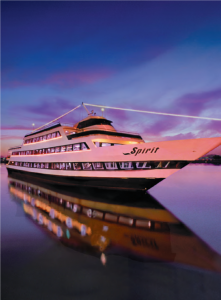 technically, the morning) away.
technically, the morning) away.
HOME INVASION Somewhere this evening in the Garden State, a group of ladies is enjoying a truly moving experience. They are spending the night in heaven courtesy of the Pampered Soul, whose magnificent, mobile spa rolls into your driveway to perform candlelight massages, facials, manicures, pedicures and other rejuvenating amenities.
’VETTE FLIX The good old days are still here if you’ve got a decent GPS. The Warwick Drive-In Theatre in Vernon and Delsea Drive- In Theatre in Vineland run movies past midnight and offer fully stocked concession stands. Hot buttered popcorn. A box of Junior Mints. Orange pop. Get the picture?
WINE FOR WATER I never really got over my long-ago infatuation with Love Boat. Perhaps that was what drew me to Lincoln Harbor, where Spirit Midnight Cruises shoves off at 12:30 a.m. and returns around 3:00. The journey begins with a dockside party and then it is smooth sailing on the Hudson in sophisticated style. Though true love eluded me on this particular voyage, the dancing, drinking, food and fun—not to mention the romantic views of the big city—beat the heck out of Circle Line.
NIGHTLY BREAD Whatever pundit wrote Man does not live by bread alone obviously hadn’t heard about Terrigno’s Bakery. The aroma of piping-hot loaves draws devotees down to Bridgeton right up to closing time, in the neighborhood of 12 o’clock. Think crusty on the outside, soft and doughy on the inside; seeded, whole grain, rye, sour dough, French, Italian. And for those who insist a balanced diet is a cookie in each hand, Terrigno’s also turns out a spectacular array of sweets, pastries, cakes, pies, and tarts. Bring an extra pair of hands.
LOUNGE ACT Frank Sinatra’s first group went by the name The Hoboken Four. Old Blue Eyes knew his way around the Mile Square City’s backstreets, bars and juke joints in the 30s, but even he might be overwhelmed by the after-midnight choices in the town today. Among Hoboken’s new and noteworthy hotspots is Lounge 11, at 505 Madison Street. An exclusive nightclub, bar and restaurant, it combines contemporary design with a hip New York atmosphere. The music selection is diverse, as is the crowd scene—especially on weekends.
SPIRIT OF DISCOVERY If you’re searching for weird in New Jersey in the pre-dawn hours, as a rule you shouldn’t have to look very far. If you’d prefer a more structured foray, then head to Ocean City, where eerie sounds and sightings highlight the candlelight strolls led by the Ghost Tours staff. No two tours are alike, says one guide, because “many strange and unusual things have been picked up on digital cameras. At times, even my own hair stands on its ends.”
STAR POWER Leave it to New Jersey’s own Ivy Leaguers to keep our eyes trained skyward all night. The Amateur Astronomers of Princeton have focused their know-how, curiosity and enthusiasm on princetonastronomy.org, an astronomy and cosmology web site that lets us know what to look for on those early a.m. strolls. A 24-hour phone line (609) 737-2575 suggests the best time to wish upon a falling star or view a cosmic display, and alerts callers to sudden developments in the night sky. A recent call described an unusual lunar citing visible at 3:00 a.m. Live updates are also available to Tweeters at princetonastro.
COUNTER CULTURE You knew this was coming, right? New Jersey is world renowned for its diners, and rightfully so. Entire books and web sites have been devoted to the subject. Golly, a whole page in this issue of EDGE has been devoted to diner culture! Rather than debate the relative merits of the Garden State’s classic eateries, I’ve chosen one to represent them all. The Mastoris Diner in Bordentown has been satisfying appetites and clogging arteries for more than four generations. An endless menu only hints at the jaw-dropping portions that cascade out of the Mastoris kitchen—which often serves 2,500 customers a day. Technically this is not an all-night diner; the Mastoris staff catches its breath for a couple of hours after 1:00 a.m. every morning. But that has not kept it from becoming one of Jersey’s most cherished late-night traditions.
Desperately Seeking Solitude
“I love tranquil solitude…” Shelley, the ill-starred poet, he of the golden pen, knew the true value of solitude. And so do we. All around, we see the vaunted worth of the priceless melt away. The most highly prized dwindles, fades into the commonplace. But solitude eludes the calipers of ordinary measure. Not easily found today. How much more difficult tomorrow? Solitude. Such a luxury. No, the new luxury. It’s the exclusive reserve of the wealthy…or the ingenious. Presented in these pages, still spared the encroachment of progress, crowds and all manner of acclaim, is a choice selection of refuges where Solitude is valued above all else.
Musha Cay
David Copperfield, who just happens to be the owner of Musha Cay in the Bahamas, modestly calls his island, “the most beautiful place on the globe.” Not for anyone who wants to rough it. Rather a refuge for anyone who unashamedly wants to be spoiled. The island is staffed by gentle folk whose pleasure it is to see that you are content, content, content…morning to night. To be left in peace. Swim in the free-form beach-side pool or fl oat the day away in the calm of the Caribbean. Take a turn at wind-surfing, a spell of snorkeling, tennis on a flood-lit court. Picnic on a different beach every day. While you’re in residence, you’re the supreme command. You can rule your kingdom in solitary splendor or share it with up to a dozen forever-grateful friends. Your modest housing is Highview, a manor house of 10,000 square feet, rimmed by mahogany decks with views of the far rim of the world. Travel to and from Musha Cay is via the island’s Twin Otter aircraft, transport deemed more than satisfactory by the likes of Robin Williams, Oprah Winfrey, Tim McGraw and….oh why go on and on. Isn’t it enough to promise that on Musha Cay you will be….well, let’s just say: Content.
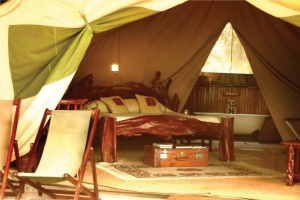
Photo by Erico Hiller
Lamu
One of seven islands lying just off the east African coast. Today its political allegiance is to Kenya. Its cultural allegiance, however, is to the 15th century, when Arab traders sailed the seas unmolested and wealthy beyond all imagining. Their ways are here preserved. Revered. Life in these narrow, crooked streets moves no faster than a donkey’s pace…the same donkeys that still carry water jugs from well to dwelling. The beaches, called shela, are broad. White. Empty. The sea is limpid. Stay in a guest house, reserved for you alone. Barefoot girls, veiled in white linen, place baskets of mango and papaya on the doorstep at dawn. Feast by moonlight on the catch brought fresh from the sea by fishermen sailing the dhows built by their fathers and grandfathers. Each day is chanted into wakefulness by the imam high atop the ancient mosque. Here Swahili is the spoken word. Karibu. Welcome…welcome to Lamu.
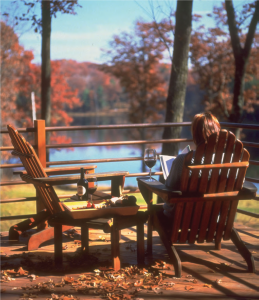
Photo courtesy of Canoe Bay
Canoe Bay
Solitude, serenity, sylvan quiet. Enshrined deep in the Wisconsin woodlands, Canoe Bay is situated on the edge of deep, glacier-formed Lake Wahdoon. Nature provides the setting. Frank Lloyd Wright provided the inspiration by which this one-of-a-kind resort takes architectural shape. Rattenbury Cottage is hidden away on a 280-acre property. Designed by one of Wright’s most astute devotees, it features the open-air layout that characterizes so much of the Great Master’s creations. A large living room with soaring ceilings, polished wood paneling and massive stone fi replace…king-bedded sleeping space, huge bathroom with two-person whirlpool spa, gleaming white oak floors, broad cantilevered deck with unimpeded lake vista…it all adds up to privacy, promised and delivered. No motor boats or jet skis disturb the lake’s tranquility. The fully equipped boathouse is at your disposal complete with kayak, canoe, paddles. The gourmet picnic basket is only a phone call away. Dine in the cottage, on its deck, or if you prefer, in Canoe Bay’s glass-enclosed lakeside dining room. Under the star-studded night skies, the call of the loons is unchanged since primeval times.
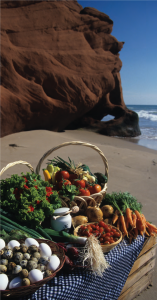
Photo courtesy of Iles de la Madeleine
Iles de la Madeleine
Adrift in Quebec’s Gulf of St. Lawrence, the Iles de la Madeleine (aka Magdalen Islands) form an archipelago some 65 miles long, bent like a fishhook…a dozen islands, home to the Acadians. Longfellow immortalized the Acadians with his well-beloved poem, “Evangeline.” But Longfellow’s Acadians fled the tyranny of Britain to settle in Louisiana. He said not a word about those who eschewed Louisiana in favor of staying in what Canadians affectionately term “the Maggies.” Theirs is a unique community….sea-faring, song-loving, proud of their heritage. Hospitable to visitors, perhaps because so few fi nd their way to these charming wave-washed specks of land. Red cliffs, green hills and golden beaches. A meterological quirk assures mild winters, warm autumns, gentle summers. The people have lovingly preserved the French of yesteryear…musical in its cadences, well suited to a pace of life unmatched in the world beyond the horizon. Here life is governed by tide and wind, by surf and wave. Once a true convent, today the Domaine du Vieux Couvent receives no more than a handful of visitors at a time. Each is settled into comfortable suites, tucked between a lighthouse and a working fishing pier. Walk the beaches in peace. Consort with seals and dolphins. Ship out to sea for the day with a pecheur who will gladly take you aboard. Feast by candlelight on freshly hauled lobster and crab…on greens grown right here in island gardens. A glass of vin ordinaire in the local café. A lesson in surf casting taught by the great-great grandson of an islander who cast into these very waters a century and a half ago. Pack a sweater, sunglasses, bathing suit. Leave behind your watch and calendar, your laptop, your cell phone. Time in the Maggies is unrelated to the time you leave behind at home.
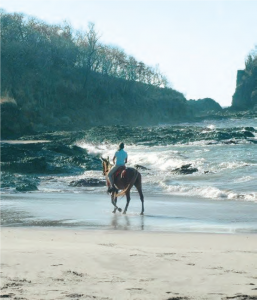
Photo courtesy of Cabo Velas
Cabo Velas
On the dry breezy coast of the Guanacaste region of Costa Rica, just north of the town of Tamarindo, that’s where you’ll find Cabo Velas. A traditional working ranch, complete with livestock and tropical orchards sprawled over 1700 acres on a secluded seaside peninsula. Yours and only yours. A week? A month? Whatever. No other guest sets foot on those 1700 acres while you’re in residence. Your life unwinds in a thatched rancho. Your large bedroom and separate dressing room open onto a beachfront verandah. Shower indoors or out. Upstairs…a second slightly smaller suite. A guest or guests? It’s your say. Swim on any of five…yes, five…beaches, each secluded by seagrape, hibiscus and palms. Snorkeling, diving, kayaking? Of course. Or perhaps a ride before breakfast along a Pacific beachfront. Dine in the Rancho Principal, a screen-surrounded dining room, edged by a two-level terrace and beyond….the salty deep. White water rafting, golf, tennis, cycling…only 30 minutes away. But really, just staying put at Cabo Velas in the heartland of Costa Rica will doubtless suit you very, very well. Cabo Velas. Olé!
Editor’s Note: For more information on these properties, log onto the following web sites: MUSHA CAY (mushacay.com); CANOE BAY (canoebay.com); DOMAINE DU VIEUX COUVENT (domaineduvieuxcouvent.com); LAMU (magicalkenya.com).
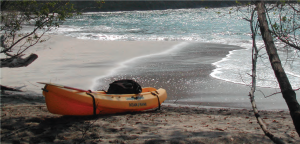
Photos courtesy of Cabo Velas
When Hollywood needs a go-to country, it goes to Morocco
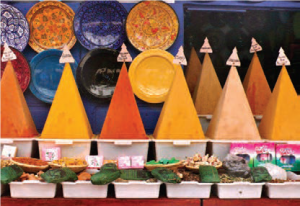 Here come the choppers. Swirling into Mogadishu. Smoke, dust and sand fill the screen. Swarms of half-naked kids race past adobe buildings that explode into flames and deadly debris. Somalia never looked more hellish. The American Rangers never looked more battle-ready. It’s Blackhawk Down—based, of course, on actual events and directed by Ridley Scott, who is mighty pleased with his blockbuster film. Dramatically a winner, financially a dreamboat that, reportedly, earned its investors “ten bucks on the dime.” And filmed On Location. Switch to Lebanon’s land-mined desert. Leonardo DiCaprio, hands aloft in surrender, must outfox both the ill-advised CIA as well as the local terrorists.
Here come the choppers. Swirling into Mogadishu. Smoke, dust and sand fill the screen. Swarms of half-naked kids race past adobe buildings that explode into flames and deadly debris. Somalia never looked more hellish. The American Rangers never looked more battle-ready. It’s Blackhawk Down—based, of course, on actual events and directed by Ridley Scott, who is mighty pleased with his blockbuster film. Dramatically a winner, financially a dreamboat that, reportedly, earned its investors “ten bucks on the dime.” And filmed On Location. Switch to Lebanon’s land-mined desert. Leonardo DiCaprio, hands aloft in surrender, must outfox both the ill-advised CIA as well as the local terrorists.
It’s Body of Lies and we don’t have to worry about Leo’s ultimate success. It’s never in doubt. Also filmed On Location. On a less hair-raising note, let’s zoom in on Sarah Jessica Parker who, as Carrie Bradshaw, sits quaffing champagne, flanked by her faithful trio of gal-pals. She’s draped in radiant silks, legs akimbo, on a priceless oriental rug in the deepest recesses of the Shah’s palace in Saudi Arabia. Precise location? Undisclosed for security concerns. Again, filmed On Location. And let’s not overlook those intrepid swashbucklers: Sean Connery, Christopher Plummer and Michael Caine. Resplendent in Her Majesty’s gold braided, brassbuttoned Imperial uniforms, braving the blizzards of India’s Himalayan heights. It’s India-profound.
The British Empire is in full flower. The Man Who Would Be King, first conceived by that old imperialist himself, Rudyard Kipling, whose saber-rattling novel was lovingly transposed into film by John Huston. And, yes, filmed On Location. On Location. Magic words. They convey authenticity and sky-high budgets. They conjure up drama, adventure, exotica and romance with a capital R. Somalia, Lebanon, Saudi Arabia, India. No expense spared. And who stops to ask, “Yes, but what location?” The answer lurks in the rapidly rolling credits, just before the screen goes blank. Just before the lights come up and you’re reaching for your hat, the car keys and those missed messages on your cell phone. Or pushing the little square button on the remote. So no wonder you missed that split-second phrase that so graciously thanks King Hassan II or, more recently, King Mohammed VI and the People of Morocco. This is one of the film industry’s best-kept secrets, a secret that delights directors and accountants and—Surprise! Surprise!—delights even the pampered stars of stage and screen, who do not take kindly to life in the rough. Everyone who is anyone in the film industry, it seems, knows full well the advantages of shooting a film in Morocco.
Fooling the Camera For starters, there’s the easy accessibility to every kind of scenery. Snow-crested mountain peaks in the Atlas Mountains. Endless vistas of sandy shorelines, both Atlantic and Mediterranean. Boulder-studded canyons like Glaoui Kasbah, Ait Benhaddou Kasbah, and Valley of the Nomads. Cascading waterfalls, rushing rivers, tranquil lakes and infinities of golden Saharan sands. Remember that scene in The English Patient? There is Ralph Fiennes, the love-stricken English-speaking Hungarian spy. He has settled his wounded amour, Kristin Scott Thomas, the seductive Katharine, in the depths of an Egyptian cave far out in the Sahara. She’s gravely wounded. One last, long embrace. As defense against the inevitable dark, she has only a faltering flashlight and a tattered copy of Herodotus.
Off he sets across the endless desert sands seeking help. We see him silhouetted on the far horizon, staggering, parched, heat stricken, doomed. All around the desert folds and unfolds into time without end. A nine-Oscar triumph! But forget all that about Egypt. From start to finish it was made not in Egypt, but a thousand miles to the west, in Morocco. Another smash hit filmed On Location It’s not just that Morocco can provide lookalike landscapes that easily pass for the Australian outback, a Hopi reservation, the jungles of the Amazon or the icy passes of the winter-bound Ural Mountains. Have you even an inkling how many scores of films are made every year based on the Bible, the Torah or the Quran? Morocco has every holy answer from the Temple of the Pharisees to the stable of the nativity. And if you’re a filmmaker with a tight shooting schedule and a dicey budget, it does not hurt one whit that Morocco can truthfully claim 360 days a year of unpolluted sunshine.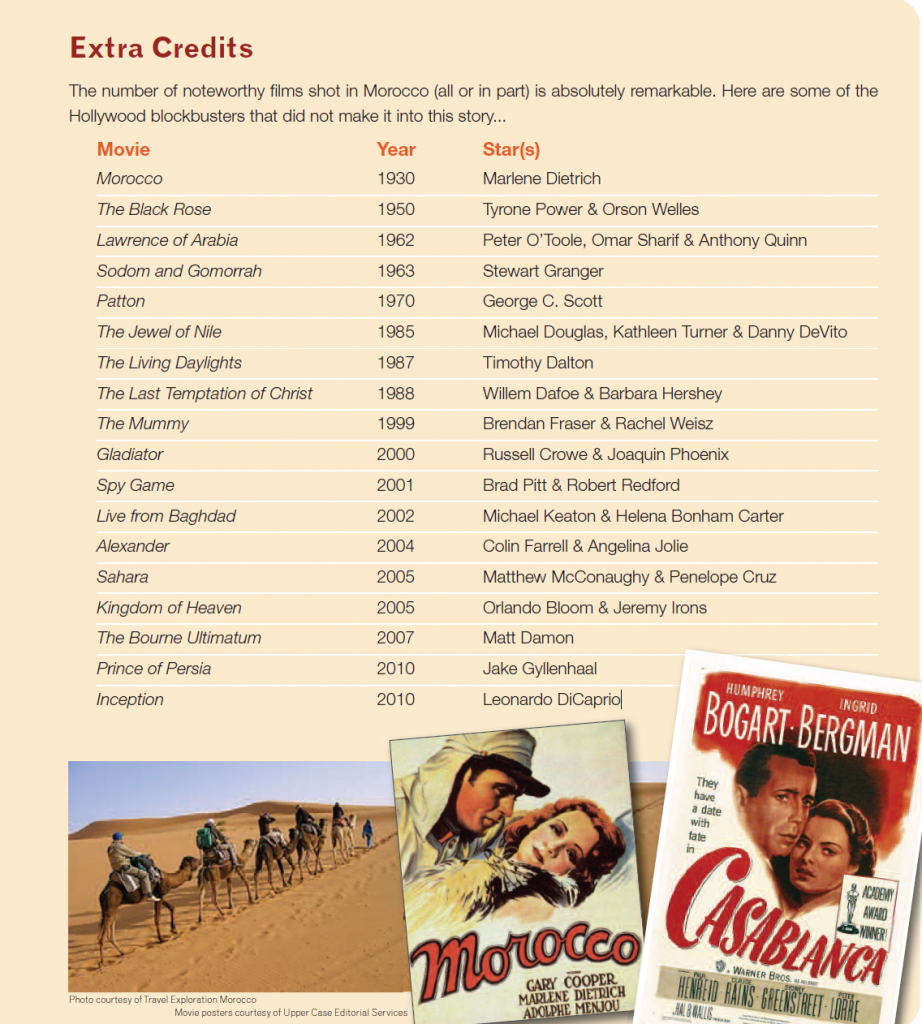
A Nation of Extras The silver screen’s love affair with the country dates back to 1897, when that French film pioneer, Louis Lumière took his camera crew there to film Le Chevalier Marocain (The Moroccan Knight). Orson Welles chose Morocco as the setting for his filmed version of Shakespeare’s Othello. Alfred Hitchcock made The Man Who Knew Too Much in the lush city of Marrakech, Morocco’s mecca for luxury lovers, be they movie moguls or run-of-the-mill zillionaires. Not surprisingly, so many decades of movie making has worked a kind of mutation on the DNA of the people of Morocco. It seems as if every man, woman and child has worked as an extra (a delightful gimmick for supplementing a daily wage). When Martin Scorsese on a morning needed a huge crowd of palm-waving devotees to welcome the Saviour into Jerusalem in The Last Temptation of Christ, the crowd was easily whistled up on minimum notice.
He could have had his crowd barefoot or sandal-clad. Or a bit of both. Everyone arrived authentically garbed in robes lifted right out of the Gospels. When, that very afternoon, the schedule called for a mob of enraged citizenry shrieking for a crucifixion, the morning crowd had no trouble “switching allegiance.” Strikingly handsome Tahar Najoui, 40-ish, who works for Travel Exploration Morocco as an expert van driver, delights in transporting tourists, film crews and movie stars to every corner of his native land. He modestly admits to acting as an extra in “more films than I can count.” The maid who tidies your room in the Berber Palace Hotel has probably played in half a dozen filmed street scenes. Her kids have happily passed for street urchins in ancient Rome or child soldiers in some Central African civil war. Your bus driver probably marched with Alexander the Great or stormed the ramparts of a 12th century fortress. Casting epic films on location in Morocco is the least of a director’s worries.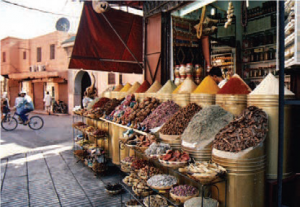
French Connection The French, who for many years affectionately called Morocco their Protectorate, have long since pulled up colonial stakes and retreated back to chez-eux. But as is so often the case, their legacy is very much in evidence. The engineering marvel of incredible road networks that join sea to mountain to desert was actually built by the French Foreign Legion—once everywhere in evidence, but today a discreetly diminished presence. Arabic and Berber are Morocco’s first languages, but French is widely spoken; English, in no small measure thanks to the film industry, is coming on with lightning speed. The legacy of the French is seen in other subtle ways: The windows of the pastry shops in Fez, Rabat or Casablanca could pass for patisseries in the Rue de Rivolli or the Plâce Vendôme.
The women of Morocco, bareheaded or partially veiled, move with a feather-footed grace that typifies the Paris pedestrians. Where else in North Africa can one walk the streets unhassled, confident that the crowd in the bazaar or the souk will not suddenly turn into a mob of hostage-takers intent on flag-burning or a game of effigy hangman? In addition to great roads and a predisposition for street chic, the French also left their Catholicism, which mixes painlessly with Islam and Judaism. It’s an easy blending that conveys a very European feel to the whole country. Morocco manages to balance delicately as part-Islamic, part-Christian, part-Catholic, part-Protestant. Many (but not all) women wear head scarves but the top-to-toe burqa is an oddity. Women are welcome to drive cars, attend university and marry as they please. Secularity has the upper hand in Morocco which, alone among North African nations, is quietly funding a well-organized push to join the European Union.
Government Blessings Sunshine and incredible scenery are only part of the answer as to why movies and Morocco are such a good fit. Take a look at the coastline of North Africa. Traveling east to west, from Egypt to Libya to Tunisia, Algeria and finally Morocco. In every country political unrest, riots, arson, roadblocks and civil upheavals are daily fare. Morocco alone remains serene. By the same token, why subject Emily Blunt and Ewan McGregor to the indignities of the streets of Yemen when Morocco affords Yeman-y landscapes as good as (or even better than) the real thing? If you caught Salmon Fishing in the Yemen when it hit theaters, once again, you were on location in Morocco. “We are,” as a well-known guide pridefully told a bus full of Japanese tourists, “the Safest Door to the Desert.” With a keen nose for profit, the Moroccan government has gone overboard to eliminate red tape for movie-makers. No nasty tie-ups there about film permits. Applications are approved within 24 hours at pleasingly competitive prices, especially as compared to Europe or North America.
Furthermore, from the Mediterranean in the north of Morocco to the Sahara in the south, filmmakers can count on ready access to state-of-the-art camera equipment, experienced sound and lighting crews and catering services that will provide soufflé au chocolat, perfectly ripe Camembert or chilled to perfection Moet et Chandon—even in the far reaches of the Moroccan Sahara. No need to transport all that equipment or all those technicians from California. It’s already right there in Morocco, and available at prices that undercut all competitors. Cate Blanchett first visited Morocco when she traveled there to star in Babel. The film was a huge box office success. Whether it was the success of the film or the appeal of the country, who’s to say? But rumor has it that Australian-born Blanchett and her husband, Andrew Upton—who together act as co-directors of the Sydney Theatre Company—are now interested in setting up a similar theatrical company, probably in southern Morocco. True? Absurd? Who’s to say? But certainly for now, it’s safe to say that there will be plenty more films…as distinct from one another as Sex and the City and Saint Joan, lining up to be produced in Morocco…aka “The Other Hollywood” or, as we say in the trade, On Location.
Hot Time in the Old Town
Horns honked and car traffic surged on all four sides of Tiananmen Square. Thirty years had passed since I last set foot on these ancient stones. Back in 1981, there were 35,000 cars in Beijing. Now there are five million. Where were the waves of bicycles, the main form of transportation of Mao and Deng Hsiao-ping’s eras?
It was mid-week, mid-morning in the third-largest city square in the world—in the capital city of the most populous country on the planet. My return trip was just a few hours old and already a lifetime of change was noticeable.
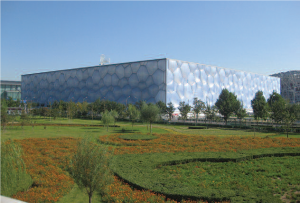
Scores of Asian tourists mingled, snapped photos and followed their leader’s flag or umbrella. Each group was differentiated by color-coded beanies of red, pink, orange, blue and even Burberry-like plaid. There were no green beanies in sight—to wear a green hat symbolizes a cuckolded husband. I imagined the bird’s-eye view of the square might look like a giant’s game of Chinese checkers.
The general appearance of the tourists spoke volumes about the changes Beijing has undergone. Head-wear uniformity notwithstanding, their attire seemed very much global, ranging from chic and muted to loud t-shirts and jeans. Where were those once-ubiquitous blue Mao jackets? These days it would probably be easier to find one on eBay. And while some of the tours were Korean or Japanese, most hailed from the Chinese provinces. The people had come to Beijing to learn and appreciate their country’s venerable history—a rare and nearly impossible pursuit for the average Chinese citizen three decades ago.
How, I wondered, are all these hard-working citizens finding leisure time to sight-see when there’s a GNP to grow? My knowledgeable guide, Steven Zeng, pointed out that these folks were likely headed to the Bird’s Nest or the Ice Cube (below), the enormous structures built for the 2008 Olympics. In Beijing,

Photo credit: iStockphoto/Thinkstock
he said, Westerners come to see the old, while the Chinese actually visit the city to see the new. If you believe the tourism numbers, more Chinese now visit the Olympic compound than visit the Great Wall and Forbidden City. Combined. The Olympic compound is a popular tourist destination, particularly if you have your children in tow.
For instance, the Ice Cube, where Michael Phelps scored eight gold medals, is now a water park with a wave machine. The eye-catching Bird’s Nest has been used for everything from soccer tournaments to opera productions, and doubles as a snow theme park in the winter. I was told you even can do your laps around the track on a Segway. Directly to the south of Tiananmen Square sits Mao’s Mausoleum, a vast granite-columned building with a yellow-tiled roof. There you can pay your respects to the embalmed leader, who lies in state in a crystal coffin. To the north beckons the Gate of Heavenly Peace, which leads to the Forbidden City, for centuries the Emperor’s domain.
Last year marked a full 100 years since the fall of the Ching Dynasty. It was a tumultuous century that saw the end of the millennia-old Imperial Dynasty system, the quasi-democracy of Sun Yat-sen, the Japanese invasion, the rise of Communism and Mao and, now, a Capitalist–Socialist hybrid featuring upward mobility and upscale stores, neither of which would have even been thinkable a couple of generations ago. The mere juxtaposition of these buildings reveals a country in transition. China is trying to embrace the old, the new and, as I found, in some cases even the retro. I was focused on revisiting former haunts—to see what had changed and what hadn’t. My itinerary, it turns out, will work just as well for a Beijing first-timer as it does for an old hand like yours truly. Whether you are mapping out your own sightseeing or evaluating tours, make absolutely sure your final picks include these excursions:
- Take a morning to stroll around the Forbidden City—the Throne Hall, the Hall of Jewelry, the courtyard decorated with nine tiled dragons (right), the Imperial emblem. Don’t be afraid to go off-piste and head west through a gate to enjoy a quiet, tree-lined walk to the Painting Museum, a 17th Century pavilion built by a self-anointed Emperor who ruled only 45 days. Most of the tourists milling around the Forbidden City are Chinese. Very few Westerners are visible.
- Grab a taxi and stop by the Temple of Heaven to the south, where the Emperor journeyed each year to pray for good crops, good weather and a good year to maintain his divine right to rule: the Mandate of Heaven. By the way, taxis are amazingly inexpensive. Just make sure you have your destination written in Chinese characters.
- Set aside a day and travel an hour or so outside of Beijing to the Great Wall, and then to the feng shui-approved Ming Tombs, where 13 Ming Dynasty Emperors are buried. Walk along the four-mile spirit-way (right).
- For an in-city getaway, visit the Summer Palace. Take a boat ride across the lake. Check out the Marble Boat built by the Dowager Empress Tzu Hsi with money earmarked to develop the Chinese navy. Stroll along covered, painted walkways.
- Climb the Bell Tower for a nice view of Beijing. Enter the touristy-but-charming shop on the ground level to sample and buy teas that they claim cure or prevent myriad illnesses, ranging from diabetes (Pu’Er), poor blood circulation (Litchi Black Tea) and even cancer (Dragon Well Green Tea).
- Visit the Yonghegong, a 17th century Tibetan Buddhist Lamasary. It originally housed court eunuchs, but after a few decades was converted into a Lama Temple. Buddhist monks still worship and tend the temple grounds.
- Explore the Hutongs. These old neighborhoods are made up of the traditional Beijing house structure: four buildings constructed around a central courtyard. Sadly, I found that many had been demolished to make way for the Olympics. Pedi-cab drivers can cycle you around these scenic and now-endangered neighborhoods.
- Shop Liu Li Chang, the “antiques” district of Beijing. The shopkeepers here are very nice and encouraging, almost to the point of being obsequious. I was told several times what a great eye I had, how I had unearthed their best treasures. The quality of the items isn’t what I remembered 30 years ago, however.
Now a few words about food. If your idea of Chinese cuisine is what the waitress brings to the table at P.F. Chang’s, you may need to adjust your expectations. When I first visited China in the early 1980s, most of the day-to-day (nonbanquet) meals were pretty greasy and sometimes mysterious in content and origin. I remember one fellow traveler, a cautious Italian, lived off a large wedge of Parmesan that he brought into the country. He would shave it onto the Chinese risotto served at each meal.
By comparison, today B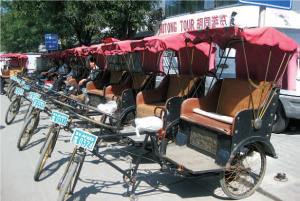 eijing’s restaurant scene is cosmopolitan. Indeed, when I asked my second-day guide, Clark Du, where I could sample a “typical” Beijing meal, he shrugged. He and his friends typically ate Italian or Japanese. I had good luck food-wise on my return to Beijing. In the spirit of full disclosure, I should mention that I stayed at the new Ritz-Carlton in the Financial District. The room was clean and sleekly comfortable and the food was very good. However, Chinese food still can range from good to bad to ugly. That being said, each meal—from the budget Jya-jiang noodles in a Hutong restaurant, to the steaming bamboo baskets of pork and crab dumplings in a fluorescent-lit shopping mall, to the bean curd and seafood served in a former Imperial garden by waitresses in Manchu robes—has its rewards. You do need to be choosy when dining out, as some aspects of Chinese food—and restaurant hygiene—are not for the meek. As a rule, I suggest staying away from spare parts.
eijing’s restaurant scene is cosmopolitan. Indeed, when I asked my second-day guide, Clark Du, where I could sample a “typical” Beijing meal, he shrugged. He and his friends typically ate Italian or Japanese. I had good luck food-wise on my return to Beijing. In the spirit of full disclosure, I should mention that I stayed at the new Ritz-Carlton in the Financial District. The room was clean and sleekly comfortable and the food was very good. However, Chinese food still can range from good to bad to ugly. That being said, each meal—from the budget Jya-jiang noodles in a Hutong restaurant, to the steaming bamboo baskets of pork and crab dumplings in a fluorescent-lit shopping mall, to the bean curd and seafood served in a former Imperial garden by waitresses in Manchu robes—has its rewards. You do need to be choosy when dining out, as some aspects of Chinese food—and restaurant hygiene—are not for the meek. As a rule, I suggest staying away from spare parts.
Steer clear of chicken or duck feet, tripe, and intestines, not to mention sea cucumbers and sea slugs. When I was there, th ere was hoopla about a funny story on Chinese food, sanitation and hygiene written by David Sedaris. To be sure, the non-hotel toilets can be daunting and require strong glutes and thighs. Use your imagination. Also, it’s a smart idea to carry you own tissue in case there’s a run on toilet paper. On the bright side, I think that, thanks to the Olympics, the Chinese have cleaned up their act with respect to uncovered hacking, phlegm-spitting and allowing babies to defecate in the streets. At least I didn’t notice it this trip. To many the hygiene is a deal-stopper, but to me, I say Vive la Difference. It’s all part of the great adventure that is China.
ere was hoopla about a funny story on Chinese food, sanitation and hygiene written by David Sedaris. To be sure, the non-hotel toilets can be daunting and require strong glutes and thighs. Use your imagination. Also, it’s a smart idea to carry you own tissue in case there’s a run on toilet paper. On the bright side, I think that, thanks to the Olympics, the Chinese have cleaned up their act with respect to uncovered hacking, phlegm-spitting and allowing babies to defecate in the streets. At least I didn’t notice it this trip. To many the hygiene is a deal-stopper, but to me, I say Vive la Difference. It’s all part of the great adventure that is China.

Photo credit: iStockphoto/Thinkstock
Dress like a tourist. Eat like a local. The Ultimate Insider’s Jersey Shore Dining Guide.
Have you ever driven past one of those mysterious local eateries along the New Jersey coast and wondered aloud, “You think that place is any good?” Well,  wonder no more. We have removed the guesswork and narrowed the search. Presented here, for the very first time anywhere (that we known of anyway), is the bona fide dining guide to those neighborhood joints between Sandy Hook and Pt. Pleasant that locals swear by. Sure, you could peck away on the Internet and read all those planted reviews. Save yourself the trouble. The 60 “Shore Things” on this list are the real deal, with raves from real customers—trust us. Expect plenty of atmosphere, not too much ambiance. A few accept reservations, but most do not. Bon Appétit. EDGE
wonder no more. We have removed the guesswork and narrowed the search. Presented here, for the very first time anywhere (that we known of anyway), is the bona fide dining guide to those neighborhood joints between Sandy Hook and Pt. Pleasant that locals swear by. Sure, you could peck away on the Internet and read all those planted reviews. Save yourself the trouble. The 60 “Shore Things” on this list are the real deal, with raves from real customers—trust us. Expect plenty of atmosphere, not too much ambiance. A few accept reservations, but most do not. Bon Appétit. EDGE
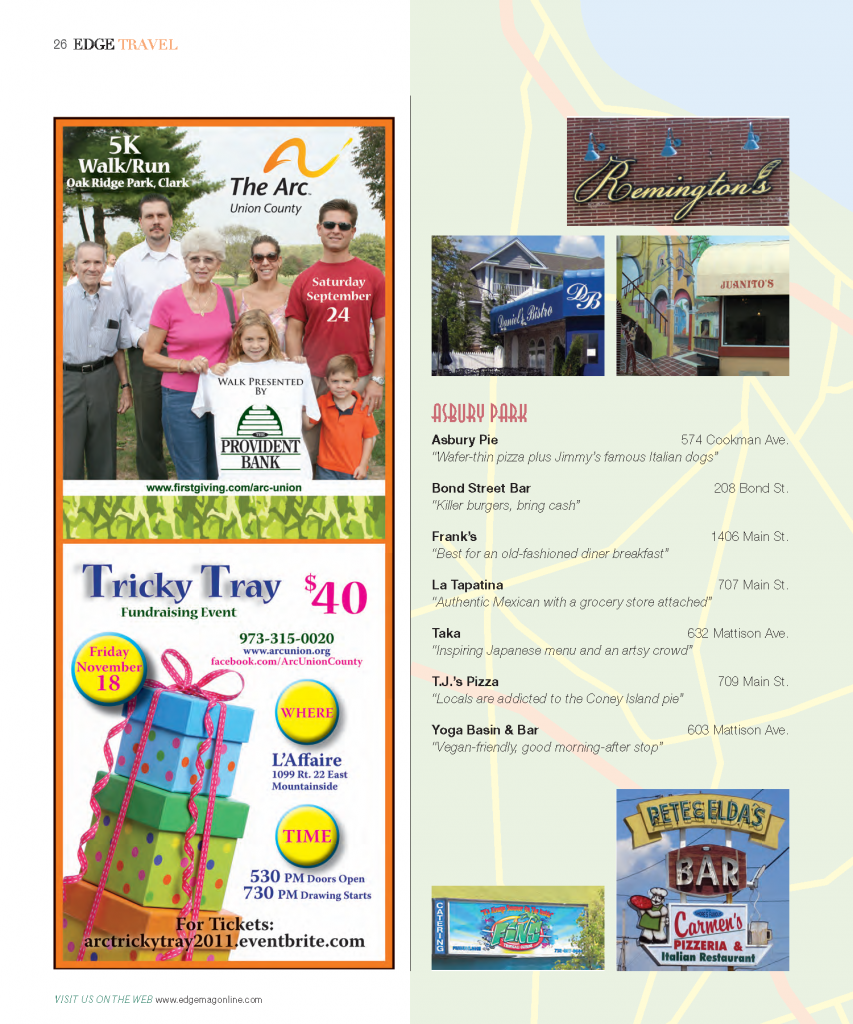


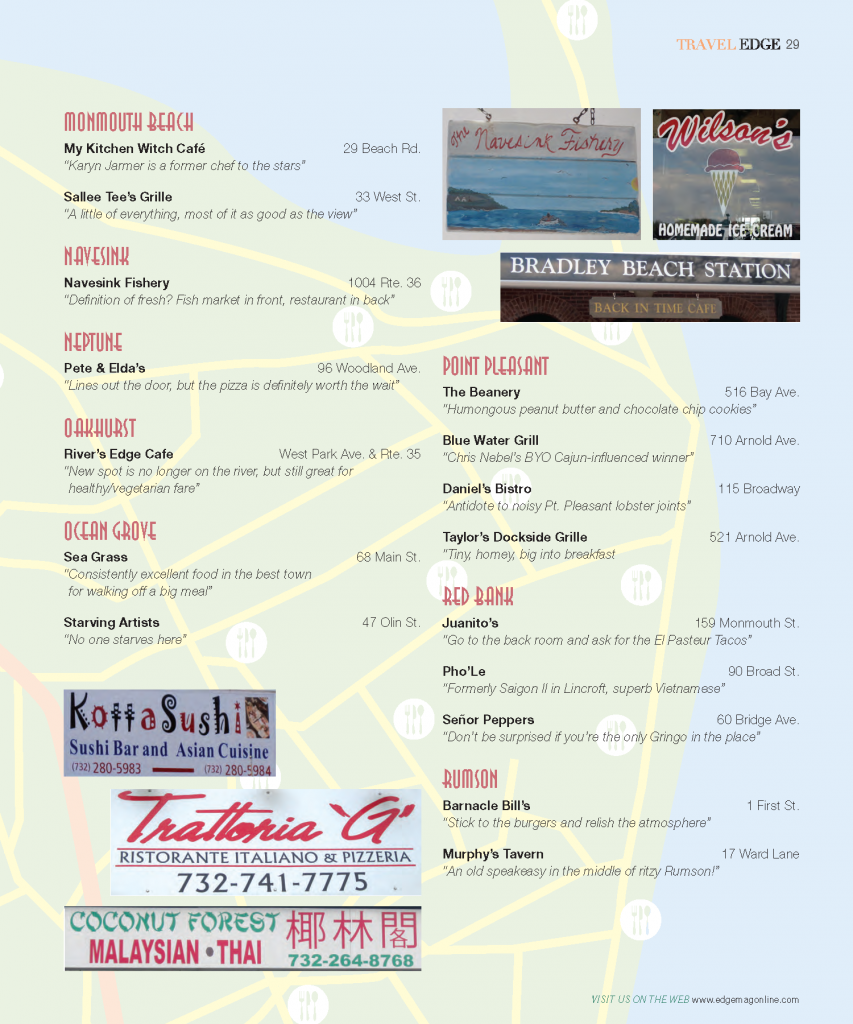
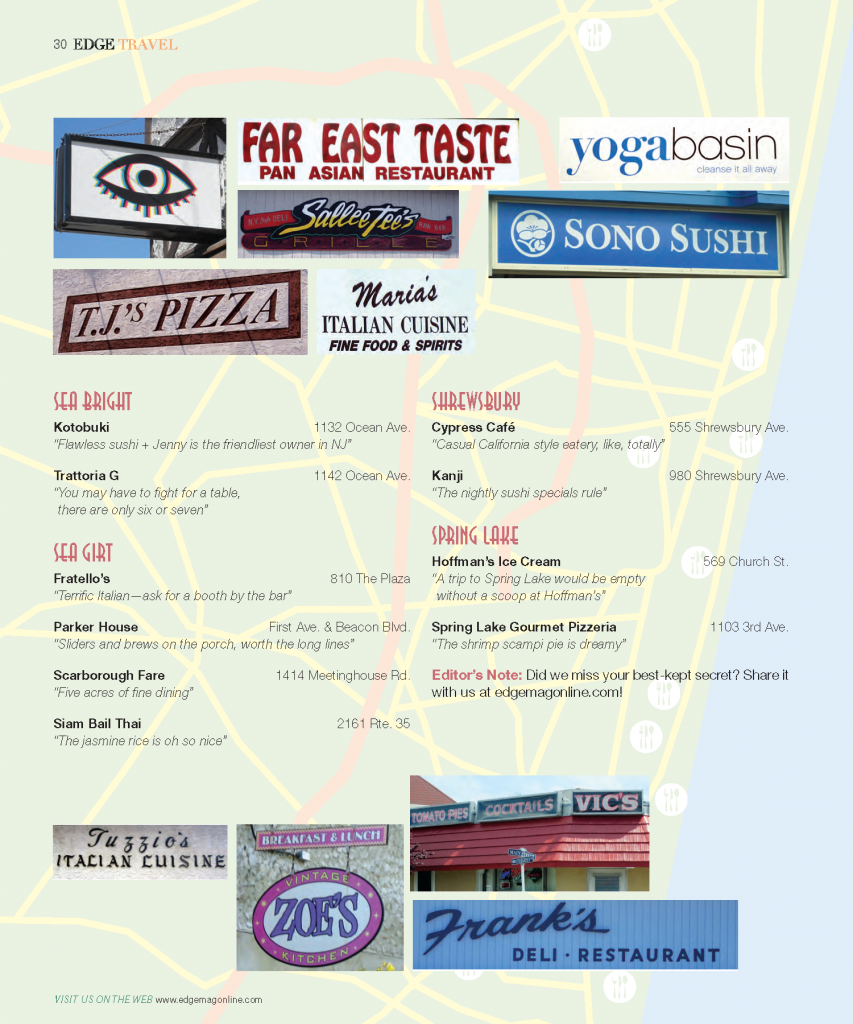
built on sand doth crumble, but the palace built on silk endures.’
—14th Century Chinese Proverb
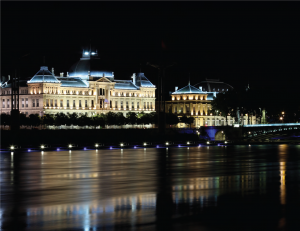 Silk, the fabric of kings and emperors—of nobility, popes and czars—has always signified wealth, prestige and luxury. Always? Probably, that is if you agree that a commodity cherished since 5000 B.C. merits such a term of longevity. Pharaohs dating back at least that far have been disentombed, their royal cadavers worshipfully swathed in silk. In ancient Rome, the wearing of silk was forbidden the ordinary citizen. Only members of the imperial family could appear in public wearing it. In Europe, by the 15th century, the French city of Lyon was calling itself the Silk Capital of the World.
Silk, the fabric of kings and emperors—of nobility, popes and czars—has always signified wealth, prestige and luxury. Always? Probably, that is if you agree that a commodity cherished since 5000 B.C. merits such a term of longevity. Pharaohs dating back at least that far have been disentombed, their royal cadavers worshipfully swathed in silk. In ancient Rome, the wearing of silk was forbidden the ordinary citizen. Only members of the imperial family could appear in public wearing it. In Europe, by the 15th century, the French city of Lyon was calling itself the Silk Capital of the World.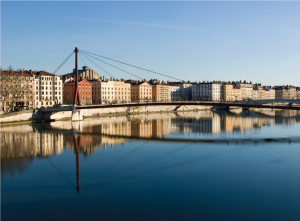 How justified was that claim? Well, when that bit of braggadocio first surfaced, it’s more than possible that China, Korea, India and who knows what other kingdoms might well have challenged Lyon for the title. But today, in the rarefied world of haute couture, Lyon with its silken boast, is right on the money. A city of half a million, Lyon is situated between two rivers: the fast-flowing Rhone and the gently flowing Soane, both passing the city, southbound to the Mediterranean. Of its long and proud history, suffice it to say that it once was the capital of Gaul and often visited by more than one Emperor. In the last two or three years, the traboules of Lyon, those 18th-century covered passageways that crisscross the silk workers’ district, have seen a virtual stampede of designers and couturiers. They fly in from Milan, New York, Tokyo and all points in between. Their names read like a celestial roll call in the paradise of high fashion. Dior, Lanvin, Chanel, Versace, Vera Wang. They come intent on securing exclusivity, or the nearest thing thereto, on the exquisite fabrics that spill forth from the looms of Lyon. Silk, which never ever was out, is now more than ever in. From the silk-wrapped heels of shoes by Dries van Noten to the extravagant ruffles of Lanvin’s evening wear, the word is SILK. Contradicting everything that fashion pundits know about trend, style and fad, silk retains its hold on elegance even while it also successfully teams up with jeans, beach wear and the most casual of the casual. Not possible! Yet true. Lyon owes much of its silky prestige to François I, the first Renaissance king to grace the French throne. A major patron of the arts and a great admirer of Italian style and elegance, he was determined to see France surpass Italy in all artistic endeavors. To that end he persuaded the great Leonardo da Vinci to quit his native Tuscany and come to live in France. Leonardo packed up bag and baggage, tucking into his luggage his favorite opus, “La Gioconda” (aka Mona Lisa). After he died in 1519, cradled in the arms of a weeping King François, that masterpiece became French property. Today it hangs in the Louvre in Paris where, as a touristic attraction, it ranks second only to the Eiffel Tower. Apart from luring Leonardo and his Mona Lisa to France, Francois I also determined that the weavers of Lyon, specialists i
How justified was that claim? Well, when that bit of braggadocio first surfaced, it’s more than possible that China, Korea, India and who knows what other kingdoms might well have challenged Lyon for the title. But today, in the rarefied world of haute couture, Lyon with its silken boast, is right on the money. A city of half a million, Lyon is situated between two rivers: the fast-flowing Rhone and the gently flowing Soane, both passing the city, southbound to the Mediterranean. Of its long and proud history, suffice it to say that it once was the capital of Gaul and often visited by more than one Emperor. In the last two or three years, the traboules of Lyon, those 18th-century covered passageways that crisscross the silk workers’ district, have seen a virtual stampede of designers and couturiers. They fly in from Milan, New York, Tokyo and all points in between. Their names read like a celestial roll call in the paradise of high fashion. Dior, Lanvin, Chanel, Versace, Vera Wang. They come intent on securing exclusivity, or the nearest thing thereto, on the exquisite fabrics that spill forth from the looms of Lyon. Silk, which never ever was out, is now more than ever in. From the silk-wrapped heels of shoes by Dries van Noten to the extravagant ruffles of Lanvin’s evening wear, the word is SILK. Contradicting everything that fashion pundits know about trend, style and fad, silk retains its hold on elegance even while it also successfully teams up with jeans, beach wear and the most casual of the casual. Not possible! Yet true. Lyon owes much of its silky prestige to François I, the first Renaissance king to grace the French throne. A major patron of the arts and a great admirer of Italian style and elegance, he was determined to see France surpass Italy in all artistic endeavors. To that end he persuaded the great Leonardo da Vinci to quit his native Tuscany and come to live in France. Leonardo packed up bag and baggage, tucking into his luggage his favorite opus, “La Gioconda” (aka Mona Lisa). After he died in 1519, cradled in the arms of a weeping King François, that masterpiece became French property. Today it hangs in the Louvre in Paris where, as a touristic attraction, it ranks second only to the Eiffel Tower. Apart from luring Leonardo and his Mona Lisa to France, Francois I also determined that the weavers of Lyon, specialists i n the secrets of silk-making, should be elevated to the front ranks of French commerce. To accomplish his objective he opened the royal purse strings to attract Europe’s finest weavers. Before his reign ended in 1547, Lyon was acknowledged as the primary source for the finest silks the world had ever seen. For the next 300 years, the weavers of Lyon thrived, lodged in high-ceilinged buildings, designed to accommodate their huge hand-operated looms. Today the looms of Lyon are high-tech marvels, controlled by computers. But in the section known as Croix Rouge, a handful of the ancient looms remain. To the delight of tourists, the weavers perform their ancient rites, still turning out priceless yardage. Few who watch the process escape a visit to the adjoining gift shops, all amply stocked with scarves, shawls, ties, skirts, shirts, purses, bedding, all of course of priceless silk. “I use silk in every one of my collections,” says Andrew Gn, the Singapore-born, Paris-based designer whose highfashion creations are carried by Bergdorf Goodman. “Silk drapes much better than anything else…and the contact of silk with skin is irreplaceable.” In his forthcoming Spring/Summer 2011 collection, Gn uses a magnificent triple-silk crepe, specially woven for his atelier. As he puts it, “Silk translates colors much better; it makes them extremely rich.” His clientele consists in large part of individuals seeking one of- a-kind creations which can be worn in the sure knowledge that her choice will not be replicated. (It’s an assurance that doesn’t come at bargain prices!) Monsieur Gn’s clientele, which includes a healthy smattering of royalty and easily-recognized names from the world of diplomats and heads of state, professes fierce loyalty to their designer of choice. Simply put, “He’s a genius,” was the gratuitous observation by an obviously satisfied client. For Andre Claude Canova, a passion for the silks of Lyon began more than a quarter of a century ago. Today he designs his own collection, which includes the most exquisite silk scarves—some of which encompass as many as 15 or 20 different colors, an achievement unequalled by any other designer. His studio at 26 Quai St.Vincent in the heart of Lyon is an old Carthusian residence, its entrance a handsome horseshoe-shaped Renaissance staircase. Favored buyers are received in its superbly furnished salons, the walls lined with…what else? Pure silk. The ambience is unmistakably Old World but the scarves, vests, pillows and jackets are on the very cutting edge. His own special design of scarf suspenders created a minor tsunami in the world of fashion when they first appeared. Supermodel Jerry Hall was so enchanted with them that she ordered 20 pairs. Princess Caroline of Monaco is frequently photographed in them and when the G-7 convened in Lyon, Bill and Hillary were delighted to be presented with a selection of Canova scarf-suspenders. An undoubted original, Andre Claude-Canova, when asked the source of his creative inspirations, replied, “Travel, history, nature.” He went on, “It can be a sunset in Tuscany, the masks of the Maasai, the silky pearl shades of a Maharajah’s robes, or the jewels of the Taj Mahal…” But the one constant in all of his creations is silk, woven in an unmatched panoply of colors. The distinction of being the oldest silk factory in Lyon belongs to Prelle et Cie, which has been in continuous operation since 1752 and is owned today by direct descendents of its founders. Apart from its stylish contemporary output of scarves, ties, shawls and other pieces, Prelle has proven invaluable in the rarefied world of authentic restoration of palaces and castles, historical houses and public places. It counts among its restorative masterpieces the authentic recreation of the silk brocades used in the Royal Bedchamber of the Sun King, Louis XIV, at Versailles, the draperies and upholstered pieces at Biltmore in North Carolina and at Ash Lawn, the ancestral home in Virginia of James Monroe. Such historical replication of two- and three-hundred-yearold fabrics is possible thanks in part to the exquisite workmanship of the Prelle artisans, and in part to the company’s scrupulously maintained archives, which date back four centuries.
n the secrets of silk-making, should be elevated to the front ranks of French commerce. To accomplish his objective he opened the royal purse strings to attract Europe’s finest weavers. Before his reign ended in 1547, Lyon was acknowledged as the primary source for the finest silks the world had ever seen. For the next 300 years, the weavers of Lyon thrived, lodged in high-ceilinged buildings, designed to accommodate their huge hand-operated looms. Today the looms of Lyon are high-tech marvels, controlled by computers. But in the section known as Croix Rouge, a handful of the ancient looms remain. To the delight of tourists, the weavers perform their ancient rites, still turning out priceless yardage. Few who watch the process escape a visit to the adjoining gift shops, all amply stocked with scarves, shawls, ties, skirts, shirts, purses, bedding, all of course of priceless silk. “I use silk in every one of my collections,” says Andrew Gn, the Singapore-born, Paris-based designer whose highfashion creations are carried by Bergdorf Goodman. “Silk drapes much better than anything else…and the contact of silk with skin is irreplaceable.” In his forthcoming Spring/Summer 2011 collection, Gn uses a magnificent triple-silk crepe, specially woven for his atelier. As he puts it, “Silk translates colors much better; it makes them extremely rich.” His clientele consists in large part of individuals seeking one of- a-kind creations which can be worn in the sure knowledge that her choice will not be replicated. (It’s an assurance that doesn’t come at bargain prices!) Monsieur Gn’s clientele, which includes a healthy smattering of royalty and easily-recognized names from the world of diplomats and heads of state, professes fierce loyalty to their designer of choice. Simply put, “He’s a genius,” was the gratuitous observation by an obviously satisfied client. For Andre Claude Canova, a passion for the silks of Lyon began more than a quarter of a century ago. Today he designs his own collection, which includes the most exquisite silk scarves—some of which encompass as many as 15 or 20 different colors, an achievement unequalled by any other designer. His studio at 26 Quai St.Vincent in the heart of Lyon is an old Carthusian residence, its entrance a handsome horseshoe-shaped Renaissance staircase. Favored buyers are received in its superbly furnished salons, the walls lined with…what else? Pure silk. The ambience is unmistakably Old World but the scarves, vests, pillows and jackets are on the very cutting edge. His own special design of scarf suspenders created a minor tsunami in the world of fashion when they first appeared. Supermodel Jerry Hall was so enchanted with them that she ordered 20 pairs. Princess Caroline of Monaco is frequently photographed in them and when the G-7 convened in Lyon, Bill and Hillary were delighted to be presented with a selection of Canova scarf-suspenders. An undoubted original, Andre Claude-Canova, when asked the source of his creative inspirations, replied, “Travel, history, nature.” He went on, “It can be a sunset in Tuscany, the masks of the Maasai, the silky pearl shades of a Maharajah’s robes, or the jewels of the Taj Mahal…” But the one constant in all of his creations is silk, woven in an unmatched panoply of colors. The distinction of being the oldest silk factory in Lyon belongs to Prelle et Cie, which has been in continuous operation since 1752 and is owned today by direct descendents of its founders. Apart from its stylish contemporary output of scarves, ties, shawls and other pieces, Prelle has proven invaluable in the rarefied world of authentic restoration of palaces and castles, historical houses and public places. It counts among its restorative masterpieces the authentic recreation of the silk brocades used in the Royal Bedchamber of the Sun King, Louis XIV, at Versailles, the draperies and upholstered pieces at Biltmore in North Carolina and at Ash Lawn, the ancestral home in Virginia of James Monroe. Such historical replication of two- and three-hundred-yearold fabrics is possible thanks in part to the exquisite workmanship of the Prelle artisans, and in part to the company’s scrupulously maintained archives, which date back four centuries. Patterns, hand-drawn in quill and ink, with color samples provided in watercolor paints—their intricate designs sketched in painstaking detail and selected for use in palaces, stately homes, public halls—were recorded and filed. Thus modern-day restorers are able to see exactly what designs and what colors were used in specific venues centuries past. No other silk weaving establishment anywhere in the world can claim as much. In addition to its French premises, Prelle also maintains a showroom in New York at 43 E. 10th Street. Apart from its gilded salons and showrooms frequented by the world’s top designers, Lyon has more than its fair share of stylish boutiques. All along the Rue de la Republique (incidentally, the longest pedestrian street in France), the very latest trends are fetchingly displayed in shop windows. Come early December, Lyon celebrates the Festival of Lights. For one glorious week the town is lighted throughout the night. Music seems to pour from every doorway; mimes, jugglers and troupes of musicians are everywhere. It’s as if the whole city was tripping out on some incredible potion. The restaurants—1,000 of them at last count—do a landslide business, for gastronomy in Lyon is a source of huge civic pride. It’s not for nothing that Lyon is often called the “best-fed” city in France. When I repeated the epitaph to a Lyonnais, he quickly put me straight: “The best-fed city not in France, but in Europe!” So much for local modesty. Then again, it’s no mere coincidence that Paul Bocuse, the high priest of French gastronomy, chooses to live in Lyon, where he presides over two restaurants. A world famous chef who actually cooks? It sounds ordinary enough, but in the tippy-top layers of prize-winning, globally-acclaimed chefs, it’s rare enough to elicit expressions of wonder from fellow chefs. A final word of advice. Don’t journey to the city in search of bargains. It’s doubtful that Lyon even knows the meaning of the word. But if it’s quality you seek, if it’s the full value of every Euro spent, then quite definitely, Lyon may be just the city for you.
Patterns, hand-drawn in quill and ink, with color samples provided in watercolor paints—their intricate designs sketched in painstaking detail and selected for use in palaces, stately homes, public halls—were recorded and filed. Thus modern-day restorers are able to see exactly what designs and what colors were used in specific venues centuries past. No other silk weaving establishment anywhere in the world can claim as much. In addition to its French premises, Prelle also maintains a showroom in New York at 43 E. 10th Street. Apart from its gilded salons and showrooms frequented by the world’s top designers, Lyon has more than its fair share of stylish boutiques. All along the Rue de la Republique (incidentally, the longest pedestrian street in France), the very latest trends are fetchingly displayed in shop windows. Come early December, Lyon celebrates the Festival of Lights. For one glorious week the town is lighted throughout the night. Music seems to pour from every doorway; mimes, jugglers and troupes of musicians are everywhere. It’s as if the whole city was tripping out on some incredible potion. The restaurants—1,000 of them at last count—do a landslide business, for gastronomy in Lyon is a source of huge civic pride. It’s not for nothing that Lyon is often called the “best-fed” city in France. When I repeated the epitaph to a Lyonnais, he quickly put me straight: “The best-fed city not in France, but in Europe!” So much for local modesty. Then again, it’s no mere coincidence that Paul Bocuse, the high priest of French gastronomy, chooses to live in Lyon, where he presides over two restaurants. A world famous chef who actually cooks? It sounds ordinary enough, but in the tippy-top layers of prize-winning, globally-acclaimed chefs, it’s rare enough to elicit expressions of wonder from fellow chefs. A final word of advice. Don’t journey to the city in search of bargains. It’s doubtful that Lyon even knows the meaning of the word. But if it’s quality you seek, if it’s the full value of every Euro spent, then quite definitely, Lyon may be just the city for you.
EDGE Editor’s Note: Special thanks to Erick Horlin
Okay, let’s be blunt for a moment. When you think “New Jersey Dream Wedding,” that dream doesn’t really end with a two-hour jaunt down the Garden State Parkway. A week on the West Coast? That’s more like it. Ten days in Tokyo? Absolutely. A fortnight in France? Now you’re talking! Alas, the sad fact is that New Jersey couples don’t always have the days to spare for such glittering post-nup adventures. Which is why staying in-state might just be the brightest option of all. It all comes down to picking your spot. Consider if you will that, for thousands of couples from all over the world, Atlantic City is the honeymoon destination.
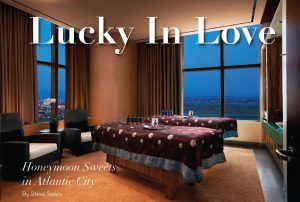
You know that surge of excitement you feel when you hit the AC Expressway? Imagine adding that to the glow of an impending wedding night. “What could be more romantic than a hotel suite with an ocean view, four miles of beautiful beaches and Boardwalk to stroll on, superior dining choices, luxurious spas and great entertainment?” asks Jeff Vasser. Okay, Mr. Vasser gets paid to plug AC. He’s President of the Convention and Visitors Authority. But the man’s got a point. Combine the indulgent pampering available to honeymooners in this town that’s “Always Turned On” with the opulent casino gambling a mere elevator-ride away, and you’ve got the makings of a winning hand. And wouldn’t you know it? Atlantic City’s top hotels are all over this honeymoon thing.
At the Trump Taj Mahal, for instance, newlyweds can choose between Romantic and Risqué. Each includes an ocean view suite in the gorgeous new Chairman Tower, a bottle of bubbly and, depending on which option they have selected, either a Romance or Risqué Intimacy Kit (contents unknown). “We created these packages to offer our guests an experience they won’t soon forget,” says Trump’s Paula Mauk, who confirms that New Je rsey honeymooners can indeed “get away without going far away.”
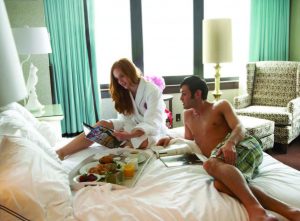
Honeymooners at the Borgata tend to gravitate toward the Spa Toccare package. It includes his & her Deep Tissue or Healing Stone Massage and Wild Lime Scalp Treatment, then a Classic Manicure and Plush Pedicure for the bride, and a Signature Shave and Express Pedicure for the groom. All those upper case letters come at a price, of course, but why pinch pennies when you can experience the ultimate in marital decompression? Next door at The Water Club—home of the exquisite topfloor, two-story Immersion pool and spa—there is a couples package on the menu that may just outdo them all. Billed as a traditional retreat to luxury, it includes a Javanese Lulur bath and body ritual that transports lovebirds back to a simpler time (like the 17th century). A side-by-side Balinese massage with jasmine frangipani oils is followed up by exfoliation with tumeric, flowers and fresh yogurt before soaking in a fragrant, floral bath, and then finishing up with an application of jasmine frangipani lotion. The bath ritual is performed in a Couples Suite with unbelievable views. Also included are a poolside manicure and pedicure, and the sublime Immersion lunch, courtesy of Chef Geoffrey Zakarian. The Water Club does not offer gaming, however the concourse connecting it to The Borgata’s casino features a gauntlet of high-end retail establishments where couples can blow their wedding checks long before they reach the tables. For newlyweds looking to hang onto their dough a bit longer, there is The Chelsea, a gambling-free boutique hotel unaffiliated with its neighbors, the Hilton and Tropicana.
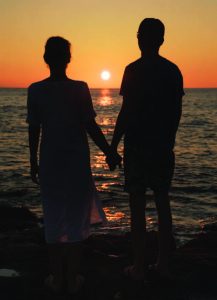
There are several packages popular with honeymooners checking into The Chelsea. The details and differences are all explained on the hotel’s web site, but the real story here is the wedding bed and the amazing rooms in the Luxe Tower. Think Egyptian cotton sheets, fluffy white duvet, and an endless supply of pillows. Think awe-inspiring views from a deck and sunroom featuring floor-to-ceiling windows. And while you’re at it, think about shelling out a couple of extra bills for one of the penthouse suites (it’s worth every penny). Finally, all of the Luxe Tower rooms at The Chelsea come with lots of whimsical touches to remind guests how very far away they are from the rest of us poor devils…even though they haven’t left the state.
According to the Mayan calendar, on December 21, 2012, the world will come to an end. Deep down, no one really buys into this apocalyptic vision. However, it would be nice to think that New Jersey is moving away from impending doom, rather than towards it. So, the question is: Are we?
When out-of-towners think of New Jersey, they tend to picture belching smokestacks, floating medical waste and other less-than-complimentary images. Unfair as that may be, the state does have a reputation for contributing more than its fair share to the world’s pollution problem. More and more, however, we hear that New Jersey is actually a leader in the Green Movement. Everyone, it seems—from cities to businesses to individual citizens—is focused on reducing our collective carbon footprint, protecting our precious resources and promoting sustainability. Granted, there is often a credibility gap between saying you’re green and putting your money where your mouth is. But as this snapshot of “where we are” shows, in many important (and surprising) ways, the Garden State really is living up to its name. Change is never easy, especially when it comes with a price tag. And make no mistake, the initial cost of going green can be steep. Yet slowly but surely, what was once a polarizing issue is becoming a foundational one. The poster child for environmental sustainability no longer sports a beard and sandals. More often than not, it’s a guy like Mike Kerwin. Kerwin is the CEO of the Somerset County Business Partnership and founder of the state’s first Energy Council. He has been at the forefront of leading the effort to make New Jersey green. Whether it’s convincing people to walk, bike, use mass transit, bring their own bags to the grocery store or reuse water bottles, he has been committed to teaching the masses how to live more environmentally friendly. Kerwin himself sees the change. Where he once found himself lecturing people on why it’s important to live green, he now spends a lot of time providing answers to inquisitive New Jerseyans on how to embrace a cleaner, healthier and more environmentally responsible lifestyle. While everyone is still watching their pennies these days, there is a general acceptance that the added cost (and effort) required to achieve these goals is worth it in the long run. “I definitely notice that younger people—starting with my own kids—seem to embrace it,” says Kerwin of going green. “I think it’s going to be a generational shift. I think ultimately there is going to be a demand for some lifestyle changes. And I think the older generation will follow suit. The case has been made that change has to be made.”
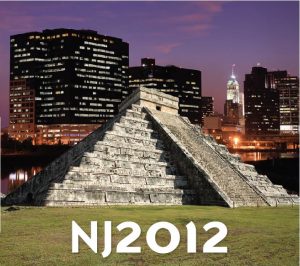
OLD DOGS, NEW TRICKS One of the most daunting obstacles to the greening of New Jersey is breaking old habits. The same person who dutifully recycles plastic bags or keeps their tires perfectly inflated may be completely resistant to a resource-preserving technology that simply rubs people the wrong way. Ted Carey knows all too well what it feels like to bump up against logic-defying behavior. His Hillsdale company, C&C Service, markets and installs LaundryPure, a device installed above the washing machine that uses the hydrogen contained in tap water to eliminate the need for hot water and laundry detergent. It saves money. It saves energy. It extends the life of clothing. And from a cost-to-benefit standpoint, the $450 LaundryPure amortizes itself in less than two years. You’d think by now every home would have one, and that Carey would be sipping Mai Tais on some beach overlooking a secluded tropical lagoon. There is just one problem.
“The promise that the unit makes is so great, that there is a natural skepticism,” he says. “Madison Avenue has indoctrinated us to believe that you need bleach and detergent in order to have clean clothes. And when something seems too good to be true, we have a tendency to move away from it.” “We need to give a unit to Oprah,” Carey laughs.

GRIP IT & RIP IT The verdant Hyatt Hills Golf Complex, situated on the borders of Clark and Cranford, was once a condemned brown site. Now it counts among its accolades the NJTA’s Environmental Stewardship Award. Hyatt Hills was reclaimed and transformed into a destination for golfers and their families, with first-rate teaching pros and fine dining.
CAR TALK Perhaps the ultimate test of our willingness to flip the switch on the status quo is the environmentally friendly automobile. America’s car culture is deeply embedded in New Jersey. Look around the next time you’re stuck at a stoplight. Almost everyone is driving something smelly, noisy, big—or some combination of the three. At what point will Garden Staters embrace hybrids like the Prius or Volt, or the batterypowered Leaf? (Note to Nissan: Real men may not drive a car called the Leaf.) The numbers are too premature to draw any lasting conclusions, but what does exist may raise a few eyebrows. Toyota dealerships like the one in Cherry Hill reported that they were having a hard time moving the Prius—and that was before the mother company’s PR nightmare. In 2008, New Jersey ranked 11th in hybrid vehicles sold, with 6,072, despite being the 9th-most populous state. According to the salespeople in Cherry Hill, the vast majority of New Jerseyans are still in love with their SUVs, and have a hard time with the concept of plugging in a car at night. The idea of not being able to go out and just start your car immediately is still viewed as a hassle versus a benefit. Not to mention that there are conversion steps the average home must undergo before it can support a hybrid vehicle.
GROWING PAINS We are what we eat. Countless studies support this old axiom. Although only a small percentage of fruit, vegetables and dairy grown in the Garden State is organic, that number has been rising dramatically as New Jersey consumers are becoming wise to the real cost of food grown with the help of chemicals, or trucked in from thousands of miles away. Business is booming at the state’s beloved produce stands, many of which feature organic goods. Meanwhile, the major grocery chains are devoting more and more space to these products. Some even have organic house brands. All told, sales of organic foods have seen double-digit percentage increases each year for more than a decade, with some years well over 20 percent. It’s a drop in the bucket, of course, but anything that heightens consumers’ awareness of the bigger environmental picture—especially in such personal terms—is a step in the right direction. Stephen McDonald would certainly agree. He founded Applegate Farms, a Bridgewater-based natural foods business, 22 years ago. Back then he and his peers seemed to be fighting a losing battle against that other McDonald’s. Today, Applegate Farms has grown from a niche market in the health-food category to mainstream markets all across the state. McDonald credits the growth of his business and others like it to the fact that New Jersey shoppers are making informed choices about what they feed their families—significantly more informed than even a decade ago. “When you walk into a store you want to understand how it was made, and what’s in it and what is not in it,” he explains, adding that “you can eat less and eat better, and it doesn’t have to cost you any more money. And it’s better for your diet. What excites us is that people are learning and becoming more engaged.”
LEARNED BEHAVIOR
Of course, a major component of changing our longterm relationship with the earth depends on setting a good example for our children. In this regard, New Jersey schools are getting with the plan. Most if not all of the major additions and renovations that have occurred in recent years have embraced some aspect of green sensibility. One of the early trend-setters was the Willow School in Peapack-Gladstone, built from the ground up in 2001. Most of the school was constructed with salvaged and recycled materials. From the wooden beams that hold up the walls to the stonework that graces the steps, much of the physical plant is experiencing a second coming of sorts. Solar pane ls have cut energy bills by as much as 70 percent, while rainwater is recycled in a filtering tank and stored for everything but drinking water. The school even has a lunchtime garden on-site. Head of School Kate Walsh is quick to point out an added benefit to going green: an enhanced learning environment. “There’s sort of a peaceful easiness in our classrooms,” she says. “We keep cool with a lot of natural air and natural light. We don’t have a lot of sickness. It’s a very healthy environment. There are no toxins, so the kids are basically healthy and the energy is really nice. What we teach our children is that they need to be responsible decision-makers as they live in the world.”

FINDING THE RIGHT MIX
Ultimately, the agent for green change in New Jersey will be a mix of common sense and economic survival. As Randall Solomon, Executive Director of the New Jersey Sustainable State Institute at Rutgers, points out, “We want to make sure the foundation of our economy and our standard of living is built on a stable foundation that will last into the future.” As for the Mayans, one might be tempted to say that they could have used a smart guy like Solomon to give them a heads-up when their society began crumbling. Then again, New Jersey might do well to take a hard look back at the lessons learned by that vanished civilization. There are some haunting parallels. Yes, we’ll make it past 2012 all right. But the next time you find yourself complaining about food and water shortages, skyrocketing fuel prices, overbuilding and overpopulation, it might be worth remembering that in responsible, proactive stewardship of the environment lies the key to the future of the state.
Editor’s Note: Zack Burgess is the Assignments Editor for EDGE. He decided to tackle this assignment himself—with assists from architect Bob Kellner and transportation Expert Josh Leinsdorf. For more information on the energySMART program call (866) NJ–SMART.







